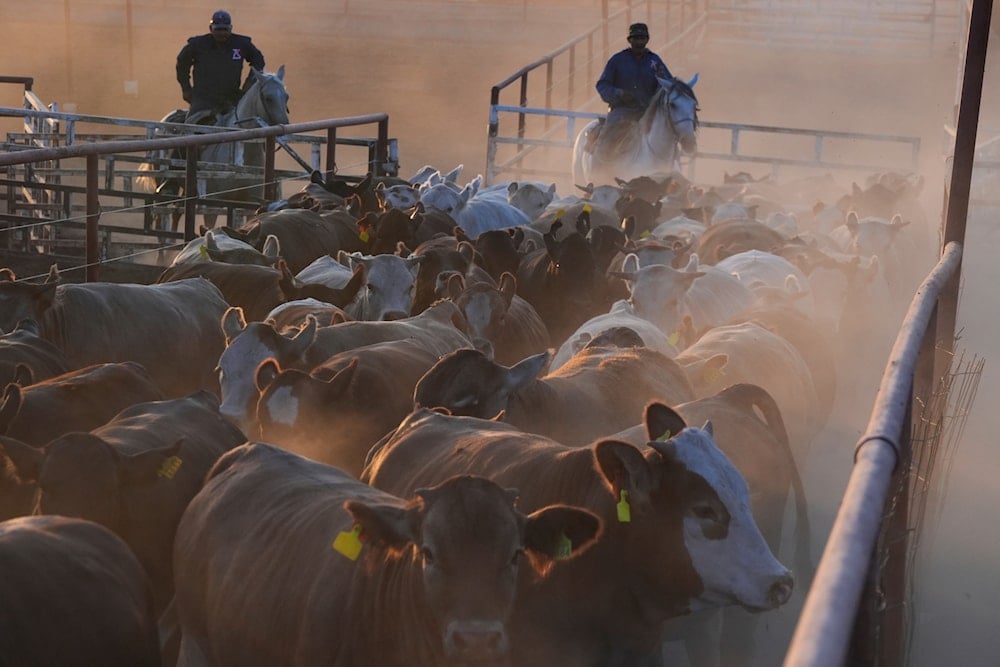CDC confirms first flesh-eating screwworm case in US
The CDC's confirmation of a human screwworm case has heightened concerns in the US beef industry, prompting USDA action and economic impact assessments.
-

Ranch hands move cattle at a ranch that supplies livestock for export to the US, in Zamora, northern Mexico, on July 29, 2025, as the US border remains closed to Mexican cattle imports over screwworm concerns. (AP Photo/Fernando Llano)
The US Department of Health and Human Services (HHS) confirmed on Monday the first New World screwworm case in the US, involving a traveler returning from El Salvador. The case, identified on August 4, was investigated by the Maryland Department of Health and the Centers for Disease Control and Prevention (CDC), according to HHS spokesperson Andrew G. Nixon.
The CDC's screwworm confirmation has stirred concern among livestock producers and veterinarians, especially as the flesh-eating parasite continues to spread northward through Central America and southern Mexico.
Nixon confirmed the case involved an individual who had traveled to El Salvador, though earlier reports from the beef industry suggested the traveler had returned from Guatemala. Nixon did not clarify the discrepancy. Despite the parasite’s severity, Nixon emphasized that "the risk to public health in the United States from this introduction is very low." No animal cases have been officially confirmed in the US this year.
Industry insiders told Reuters last week that a person infected with screwworm had traveled from Guatemala to Maryland. An executive with the Beef Alliance notified stakeholders via email of the positive case, stating the person had been treated and that prevention measures had been implemented.
Beth Thompson, South Dakota’s state veterinarian, noted that state-level officials learned of the case through informal channels and criticized the CDC for not being forthcoming with details, adding, "They weren’t forthcoming at all."
Livestock sector on edge over flesh-eating parasite outbreak
The confirmed human case of screwworm has raised alarm across the beef and livestock industry, particularly in Texas, the largest cattle-producing state. The USDA estimates a potential outbreak could cost the state up to $1.8 billion in livestock losses, labor, and medical expenses.
State veterinarians were notified informally, while the CDC referred confirmation duties to Maryland authorities. Emails obtained by Reuters suggest the CDC was obligated to inform Maryland officials and agriculture stakeholders, but the news was kept quiet to avoid market disruption amid already high beef prices.
With Mexican cattle imports restricted since November to prevent the parasite’s spread, a Texas A&M economist is assessing the economic impact of prolonged border closures. As part of its response, the USDA plans to build a sterile fly facility in Edinburg, Texas, near the site of a former eradication center, with construction expected to take up to three years, according to Secretary Brooke Rollins.
Mexico and Panama’s mitigation efforts
Moreover, Mexico is building a $51 million sterile fly facility in the country’s south to combat screwworms, joining Panama City’s plant, which produces 100 million sterile flies weekly. The USDA says 500 million is needed weekly to push the parasite back to the Darien Gap.
Screwworms, parasitic flies that lay eggs in open wounds, can fatally infest animals and, rarely, humans. Though treatable if caught early, infestations require the removal of hundreds of larvae. The parasite remains active in Central America, the Caribbean, and parts of South America, and is endemic in Cuba, Haiti, and the Dominican Republic.
Eradicated from the US in the 1960s via mass release of sterile flies, screwworms have reemerged near the US border. In July, Mexico confirmed a case in Veracruz, prompting the USDA to close southern livestock ports. With over a million Mexican cattle imported annually, the risk of infestation poses both public health and economic threats.

 4 Min Read
4 Min Read










